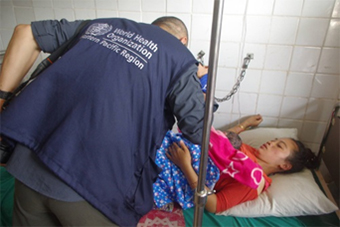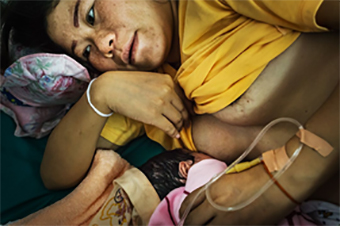It is a heart-warming scene to watch a mother holding her newborn baby for the first time, skin-to-skin on her chest, waiting for the first sign of feeding cues.
This happened at the Xiengkhuang Provincial Hospital Maternal Ward, where two mothers who have just given birth, one of them in the past hour- were experiencing the Early Essential Newborn Care (EENC) practices, introduced by WHO.
To reduce newborn mortality, which accounts for roughly 40% of all deaths under-five in Lao PDR, simple interventions have been established: immediate and thorough drying followed by early skin-to-skin contact, delaying clamping the cord after pulsations stop and prolonged skin-to-skin contact until the baby has completed his first full breastfeed.

This intervention provides the perfect temperature and security to the newborn; and supports the establishment of bonding. The baby rests between the mother’s breasts in continuous skin-to-skin contact, and may need 20-30 minutes or even more before showing signs of readiness (feeding cue) to breastfeed. Early establishment of breastfeeding is an important factor in successful breastfeeding and in association with skin-to-skin contact it reduces greatly the risk of post-partum bleeding for the mother.

EENC seeks to eliminate possibly harmful practices of health care providers, and focus only on evidence-based practices, finding values in the most natural way of caring for the newborn: staying with the mother, starting and continuing the breast feeding not hampered by any artificial milk substitute. It seeks to modify decades of routine post-natal practices in health care facilities – such as unnecessary suctioning, delayed drying, separation from the mother immediately after birth and delayed breastfeeding. Those practices have been recognized to create stress in the newborn, increasing the risk of hypothermia and hypoglycaemia as well as the risk of formula milk feeding by the relatives.
Weighing, bathing, eye care, examinations, and injections - anything that interrupts the initial skin-to-skin contact and breastfeeding- unless the baby or the mother is in distress- should be done after the baby has fully breastfed.
The support of many development partners and donors like Korea Foundation for International Healthcare (KOFIH) in Xiengkhuang and Huaphan provinces in removing the user fees providing free health care, antenatal checks and delivery services for pregnant women, and collaborating with WHO on projects like EENC are aimed at further reducing the infant mortality rates through the introduction of simple and effective interventions.
